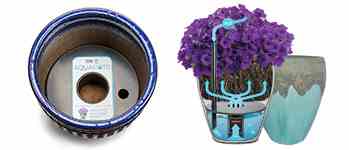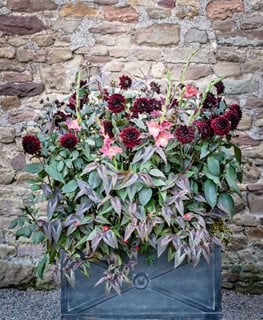5 Stunning Summer Container Combinations
These stunning summer container designs combine architectural presence, sultry colors, and abundant textures.A plant may be beautiful on its own, but its assets can be magnified when placed with plants that complement its color, structure, or textures. Case in point: a red dahlia is beautiful solo, but when paired with the lilac and peach of ‘Indian Summer’ gladiolus, the combination is a sight to behold. One of the best ways to appreciate and explore combinations is in a container. Here are a few ideas for summer combinations you can put together to bring out the best of each plant in a single pot.
Keep in mind that the plant recipes are suggestions—if you’re unable to find the exact variety, experiment with a different variety or plant with similar characteristics and features.
SUMPTUOUS SCENE-STEALER
At 5 feet tall, this glamorous grouping can serve as either a screen or a space divider. By July or August, the knotweed will explode into airy sprays of tiny white blossoms, accentuating the dark dahlia blooms and relaxing the overall look. The combination will impress for months, changing shape and color as it develops. At first it appears formal; when the gladioli are in flower and begin to pierce through the other plants, the combination takes on a jagged look; then, as knotweed bursts into bloom, the combination becomes irregular and informal.

Planting Key
A. ‘Indian Summer’ gladiolus (6-8)
B. Karma Choc dahlia (3)
C. ‘Red Dragon’ knotweed (2)
D. Cardinal climber (Ipomoea ×multifida) (3)
Illustration: Josh Endres
When to plant:
Mid- to late spring
Peak display:
Mid- to late summer
Position:
Full sun or light shade
Water needs:
Moderate to thirsty
Container size:
35" L x 16” W x 18" H
Soil:
General-purpose potting soil
Fertilizer:
Mix in slow-release fertilizer at the time of planting. After the first year, fertilize with an all-purpose liquid formulation every 2 to 4 weeks during the growing season.
Care:
Cut out the gladiolus stems immediately after they’ve finished blooming. Deadhead dahlias regularly; this variety doesn’t need staking, but other dahlia varieties may need support. Pick off faded blooms of cardinal climber to prevent reseeding.
TOWERING TRIO
Using three plants—each with different but complementary habits and similar cultural requirements—is a trusted formula in containers. Here, statuesque upright cannas rise from an anchoring middle ground of bushy coleus, and free-flowering petunias form an outer circle that trails and clambers down the side of the pot. Setting the combination in front of a relatively spare, uniformly colored background emphasizes its architectural shapeliness and pumps up the volume of its bright hues. The warm tones of the terra cotta container complement its contents, all of which revel in full sun. (You can use other varieties of cannas, coleus, and petunias to create this effect in shades of red, yellow, and pink as well.)

Planting Key
A. ‘Phasion’ canna (1)
B. Indian Summer petunia(5)
C. ‘Campfire’ coleus (3)
Illustration: Josh Endres
When to plant:
Mid- to late spring
Peak display:
Summer
Position:
Full sun
Water needs:
Moderate
Container size:
20" W x 18" H
Soil:
General-purpose potting soil
Fertilizer:
Mix in slow-release fertilizer at the time of planting. After the first year, fertilize with an all-purpose liquid formulation every 2 to 4 weeks during the growing season.
Care:
To divert energy to the foliage and encourage branching, pinch off growing tips of young coleus plants and remove flower buds. Protect cannas from slugs and snails with organic killing bait that is safe for pets and wildlife.
LEAFY MIX
The interweaving of horizontal and vertical foliages in this combination reveals engaging details that beg to be observed up close. For instance, the serrated leaves of honey bush stand out in dramatic relief where they overlay darkly contrasting sweet potato vine. The restrained, sophisticated color scheme and crisscrossing pattern are echoed in the verdigris Fibreclay planter (which is a small fraction of the cost and weight of a genuine copper container). All plants used here are usually available through much of summer, allowing you to plant late and enjoy them until frost. Beware that honey bush grows particularly luxuriantly and will eventually overwhelm the Persian shield and even the New Zealand flax, so either prune judiciously or enjoy the altered visual.

Planting Key
A. Pineapple lily (Eucomis autumnalis) (3)
B. ‘Sparkling Burgundy’ pineapple lily (3)
C. Honey bush (Melianthus major) (1)
D. ‘Bright Ideas Black’ sweet potato vine (3)
E. Persian shield (Strobilanthes dyerianus) (2)
F. ‘Apricot Queen’ New Zealand Flax (1)
Illustration: Josh Endres
When to plant:
Spring or early summer
Peak display:
Summer
Position:
Full sun or light shade
Water needs:
Daily in warm weather
Container size:
20" W x 20" H
Soil:
General-purpose potting soil
Fertilizer:
Mix in slow-release fertilizer at the time of planting. After the first year, fertilize with an all-purpose liquid formulation every 2 to 4 weeks during the growing season.
Care:
Remove damaged leaves. Prune honey bush to keep within bounds if necessary or desired. To encourage branching of Persian shield, pinch off a few growing tips.
SCENTED ARRAY
Stately flowering tobacco is the star of this planting. Its tall, handsomely foliage-clad stems shoot up sprays of white tubular blooms that are powerfully scented in the evening all summer long. Variegated maidengrass and a low froth of Diamond Frost euphorbia complete the Fountain-like look. White gladiolus blossoms lasting about 2 weeks contribute a burst of fleeting interest; the tiniest amount of buttermilk yellow at their centers gently bucks an otherwise monochrome theme. Cream-colored inflorescences emerge from the maidengrass in late summer, extending interest well through fall, after all the other flowers have faded. The planter elevates the composition to an overall height of about 6.5 feet, making an elegant statement beside an entrance or as a focal feature. Given the mature height of this planting, the container should be at least 18 inches tall.

Planting Key
A. ‘Buggy’ gladiolus (6)
B. Diamond Frost euphorbia (5)
C. Flowering tobacco (Nicotiana sylvestris) (3)
D. ‘Morning Light’ maidengrass (2)
E. Otterbossie (Gomphostigma virganum) (1)
Illustration: Josh Endres
When to plant:
Late spring
Peak display:
Mid- to late summer
Position:
Full sun or light shade; sheltered from strong winds
Water needs:
Moderate; at least every other day
Container size:
20" W x 26" H
Soil:
General-purpose potting soil
Fertilizer:
Mix in slow-release fertilizer at the time of planting. After the first year, fertilize with an all-purpose liquid formulation every 2 to 4 weeks during the growing season.
Care:
Cut out gladiolus stems after they’ve finished blooming. Then dig out and store dry corms in a frost-free place or treat as annuals. To encourage bushy, branching growth on flowering tobacco, pinch off the tips of young plants; snip off faded flower clusters to encourage more blooms. Support stems if necessary.
SHADY DISPLAY
Exotic bromeliads huddle in lush exuberance beneath the umbrella fronds of a tree fern in dappled shade. Although bromeliads are most often grown indoors, many will contentedly spend summer outside provided a minimum nighttime temperature of 60 degrees Fahrenheit. The two epiphytic species here were arranged in their individual pots at the foot of the tree fern—and loosely tied to the trunk for support—so they could be easily moved indoors during winter. Shade-loving ferns and fancy-leaved rex begonias were planted into the same humus-rich compost as the tree fern. The salt-glazed earthenware pot balances the abundant planting and picks up the browns of the Tasmanian tree fern trunk.

Planting Key
A. Urn plant (Aechmea fasciata) (3)
B. Tasmanian tree fern (Dicksonia antarctica) (1)
C. Soft shield fern (Polystichum setiferum) (3)
D. Scarlet star (Guzmania lingulata) (3)
E. Rex Hybrid begonia (3)
Illustration: Josh Endres
When to plant:
Late spring or during summer
Peak display:
Mid- to late summer
Position:
Sheltered, partial shade
Water needs:
Keep soil for ferns and begonias moist and mist others daily if possible. For the bromeliads, add water to the tiny reservoir at the center, where the colorful bracts emerge.
Container size:
24" W x 20" H
Soil:
General-purpose potting soil with additional humus mixed in
Fertilizer:
Do not fertilize the first year. After that fertilize the tree fern only during the growing season, applying a high-nitrogen liquid formulation to the crown and trunk every 3 to 4 weeks. Bromeliads last just one growing season.
Care:
Remove dead or damaged leaves, snipping out damaged begonia leaves at the base of the stems.
ONLINE LEARNING:
DESIGNING ABUNDANT CONTAINERS
Learn how to design "Pinterest-worthy" containers from container gardening expert Karen Chapman in her online course. You'll learn 6 features of well-designed containers, along with information about the best soils and fertilizers to use, as well as how to choose plants that look (and work) good together
MORE CONTAINER IDEAS
If you just can’t get enough of container gardening, take a look at these other container recipes that work well together in a single pot.
Related:
Container Gardening
Caring for Containers
Container Plants for Sun
Fall Garden Planter Ideas
Winter & Holiday Container Ideas













